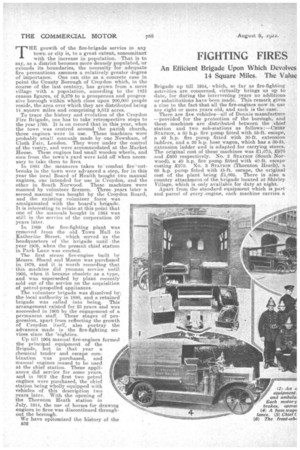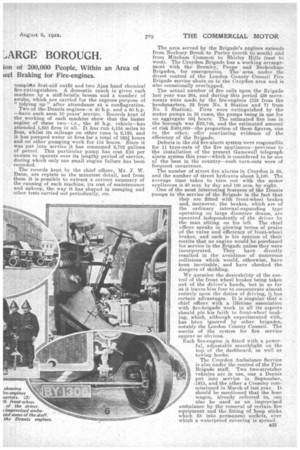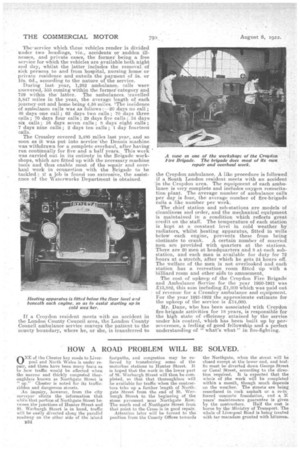FIGHTING FIRES I,ARGE .BOROUGH.
Page 16

Page 17

Page 18

If you've noticed an error in this article please click here to report it so we can fix it.
An Efficient Brigade Upon Which Devolves 14 Square Miles. The Value ion of 200,000 People, Within an Area of tee! Braking for Fire-engines.
THE growth of the fire-brigade service in any town or city is, to a great extent, concomitant with the increase in population. That is to say, as a district becomes more densely populated, or extends its boundaries, the necessity for adequate
fire precautions assumes a relatively greater degree of importance. One can cite as a concrete case in point the County Borough of Croydon which., in the course of the last century, has grown from a mere village with a population, according to the 1821 census figures, of 9,279 to a prosperous and progres sive borough within which close upon 200,000 people reside, the area over which they are distributed being 14 ,square miles and comprising 9,012 acres.
To trace the history and evolution of the Croydon Fire Brigade, one has to take retrospective steps to the year 1760. It is on record that in this year, when the town was centred around the parish church, three engines were in use. These machines were probably small manuals made by one Newsham, of Cloth Fair, London. They were under the control of the vestry, and were accommodated at the Market House. These engines had small wooden wheels, and men from the town's yard were told off when necessary to take them to fires.
In 1864 the measures taken to combat fire outbreaks in the town were advanced a step, for in this year the local Board of Health bought two manual engines, one intended for use in Croydon, and the other in South Norwood. These machines were manned by volunteer firemen. Three years later a second manual was bought by the Croydon Board, and the existing volunteer force was amalgamated with the board's brigade It is interesting to relate at this point that one of the manuals bought in 1864 was still in the service of the corporation 50 years later.
In 1869 the fire-fighting plant was removed from the old Town Hall to Eatherine Street, which served as the headquarters of the briga-cle until the year 1905, when the present chief station in Park Lane was erected.
The first steam fire-engine built by Messrs. Shand and Mason was purchased in 1879, and it is worth recording that this machine did yeoman service until 1905, when it became obsolete as a 1 ype, and was superseded by plant recently sold out of the service on the acquisition of petrol-propelled appliances.
The volunteer brigade was dissolved byi the local authority in 1880, and a retained brigade was called into being. This arrangement existed for 23 years and was succeeded in 1903 by the engagement of a permanent staff. These stages of progression, apart from reflecting the growth of Croydon itself, also portray the advances made in the fire-fighting services since the 'eighties.
Up till 1904 manual fire-engines formed the principal equipment of the Brigade, but in that year a chemical tender and escape combination was purchased and manual engines ceased to be used at the chief station. These appliances did service for some years, and in 1912 the first two petrol engines were purchased, the chief station being wholly equipped with vehicles of this description two years, later. With the opening of the Thornton Heath station in July, 1914, the use of horses for drawing engines to fires was discontinued through out the borough. . We have epitomized the history of the 3§32
Brigade up till 1914,, which, so far as fire-fighting activities are concerned, virtually brings us up to date, for during the intervening years no additions, or substitutions have been made. This remark gives a clue to the fact that all the fire-engines now in use are eight or more years old, and such is the case. There are five vehicles—all of Dennis manufacture —provided for the protection of the borough, and these machine& are distributed between the chief station and two sub-stations as follows :-CHIEF STATION, a 60 h.p. fire pump fitted with 55-ft. escape, a 40 h.p. fire pump fitted with 30-ft. extension ladders, and a 30 h.p. hose wagon, which has a 30-ft. extension ladder and is adapted for carrying stores. The original cost of these machines was £1,075, £970 and £600 respectively. No. 2 STATION (South NOTwood.), a 40 h.p. fire pump fitted with 40-ft, escape costing £970. No. 3 STATION (Thornton Heath), a 60 h.p. pump fitted with 45-ft. escape, the original cost of the plantbeing 21,065. There is also a country attachment of the brigade located at Shirley Village, which is only available for duty at niFht.
Apart from the standard equipment which is part and parcel of every ,engine, each machine carries a eomplAte first-aid outfit and two Ajax hand chemical fire-extinguishers. A domestic touch is given each machine by a stiff-bristle broom and a number of swabs, which are carried for the express purpose of "tidying up" after attendance at a conflagration.
Two of the Dennis engines—a 40 h.p. and a 60 h.p. —have each seen 10 years' service. Records kept of the working of each machine show that the busier engine of these two—i.e., the 40 h.p. vehicle—has attended 1,258 fires in all. It has run 4,134 miles to fires, whilst its mileage on other runs is 2,125, and it has pumped water at fires for a total of 1631 hours and on other pumping work for 114 hours. Since it was put into service it has consumed 2,782 gallons of petrol. This particular pump has cost E50 per annum to operate over its lengthy period of service, during which only one small engine failure has been recorded.
The records kept by the chief officer, Mr. J. W. Dane, are replete in the minutest detail, and from them it is possible to extract a correct summary of the running of each machine, its cost of maintenance and upkeep, the way it has shaped in Dumping and other tests carried out periodically, etc. The area served by the Brigade's engines extends from Norbury Brook to Purley (north to south) and from Mitcham Common to Shirley Hills (east to west). The Croydon Brigade has a working arrangement with the Bromley, Penge , and Beckenham Brigades, for emergencies. The area under the direct control of the London County Council Fire Brigade service abuts on to the Croydon area and is also occasionally overlapped.
The actual number of fire calls upon the Brigade last year was 264, and during this period 139 movements were made by the fire-engines (316 from the headquarters, 52 from No. 2 Station and 71 from No. 3 Station). Fires were extinguished by the motor pumps in 35 cases, the pumps being in use for an aggregate 59i hours. The 'estimated fire loss in the borough was £22,749, and the estimated amount at risk £464,000—the proportionof these figures, one to the other, offer convincing evidence of the efficiency of the Brigade. Defects in the old fire-alarm system were responsible. for 11 turn-outs of the fire appliances—previous to the installation of the present Gamewell telegraph alarm system this year—which is considered to be one of the best in the country—such turn-outs were of frequent occurrence.
The number of street fire alarms in Croydon is 68, and the number of street hydrants about 3,100. The average time taken to turn out with the motor appliances is 40 secs. by day and 100 sec& by night. One of the most interesting features of the Dennis pumps in the service of the Brigade is the fact that they are fitted with front-wheel brakes and, moreover, the brakes, which are of the ordinary internal-expanding type operating on large diameter drums, are operated independently of the driver by the man sitting on his left. The chief officer, speaks in glowing terms of praise of the value and efficiency of front-wheel brakes, and such is his opinion of their merits that no engine would be purchased for service in the Brigade unless they were incorporated. They have directly resulted in the avoidance of numerous collisions which would, otherwise, havebeen inevitable; and have checked the dangers of skidding.
We question the desirability of the control of the front wheel brakes being taken out of the driver's hands, but in so far as it leaves him free to concentrate almost entirely upon the duties of driving, it has certain advantages. It is singular that chief officer with a lifetime association with fire-brigade work in all its aspects should in his faith to front-wheel braking, which, although experimented with, has Men ignored by other brigades, notably the London County Council. The merits of the system for fire service appear so obvious.
Each fire-engine is fitted with a power s ful, adjustable searchlight on the top of the dashboard, as well as towing hooks.
The Croydon Ambulance Service is also under the control of the Fire Brigade staff. Two two-stretcher vehicles are in use, one a Dennis put into service in September, -,1915, and the other a Crossley commissioned in March of last year. It should be mentioned that the hose wagon, already referred to, can also be used as an improvised ambulance by the removal of certain fire equipment and the fitting of hoop sticks which fit into permanent sockets, over which a waterproof covering is spread.
The service which these vehicles render is divided under two headings, viz., aecidents or sudden illnesses, and private cases, the former" being a free service for which the vehicles are available both, night and day, whilst the latter includes the removal of sick persons to and from hospital, nursing home or private residence and entails the payment of 5s. or 10s. 6d., according to the nature of the service.
During last year, 1,282 ambulance., calls were answered, 553 coming within the former category and 729 within the latter. The ambulances, travelled 5,847 miles in the year, the average length of each journey out and home being 4.58 miles. The incidence of ambulance calls was as follows :-20 days no call ; 46 days one call ; 62 days two calls ; 70 days three calls; 70 days four calls ; 29 days five calls ;. 34 days. six calls ; 16 days seven calls; 8 days eight calls ;
days nine calls ; 2 days ten calls ; 1 day fourteen calls.
The Crossley covered 3,480 miles last year, and so soon as it was put into service "the Dennis machine was withdrawn for a complete overhaul, after having run continually for five and a half years. This work was carried out in its entirety in the Brigade workshops, which are fitted up with the necessary machine tools and thus enable most of the r•epair and overhaul work in connection with the Brigade to be tackled: if a. job is found too extensive, the assistance of the ,Waterworks Department is obtained.
If a Croydon resident meets with an accident in the London County Council area, the London County .Council ambulance service conveys the patient to the county boundary, where he, or she, is transferred to
the Croydon anibulance. A like procedure is followed if a South London resident meets with an accident in the Croydon area. The equipment of each ambulance is very complete and includes oxygen resnscitation plant.The average number of ambulance calls per day is four, the average number of fire-brigade calls a like number per week.
The chief station and sub-stations are models of cleanliness and order, and the mechanical equipment is maintained in a condition which reflects great credit on the staff. The temperature of each station is kept at ti• constant level in cold weather by radiators, whilst heating apparatus, fitted in wells below each engine, prevents these from being obstinate to crank. A certain number Of married men are provided with quarters at the stations. There are 20 men at headquarters and 8 at each substation, and each man is available for duty for 72 hours at a stretch, after which he gets 24 hours off. The welfare of the men is not overlooked and each station has a recreation room fitted Up with a billiard room and other aids to amusement.
The cost of upkeep of the Croydon Fire Brigade and Ambulance Service for the year 1920-1921 was £13,882, this sum including 21,000 which was Raid out of revenue for a Crossley ambulance and equipment. For the year 1921-1922 the approximate estimate for the upkeep of the service is 214,000.
Mr. Dane, who has been associated with Croydon fire-brigade activities for 18 years, is responsible for the high state of efficiency attained by the service under his control, which has been built up by per severenee, a feeling of good •fellowship and a perfect understanding of what's what "in fire-fighting.
































